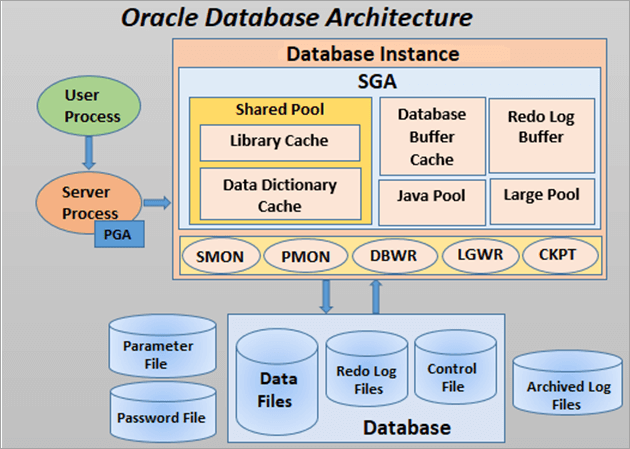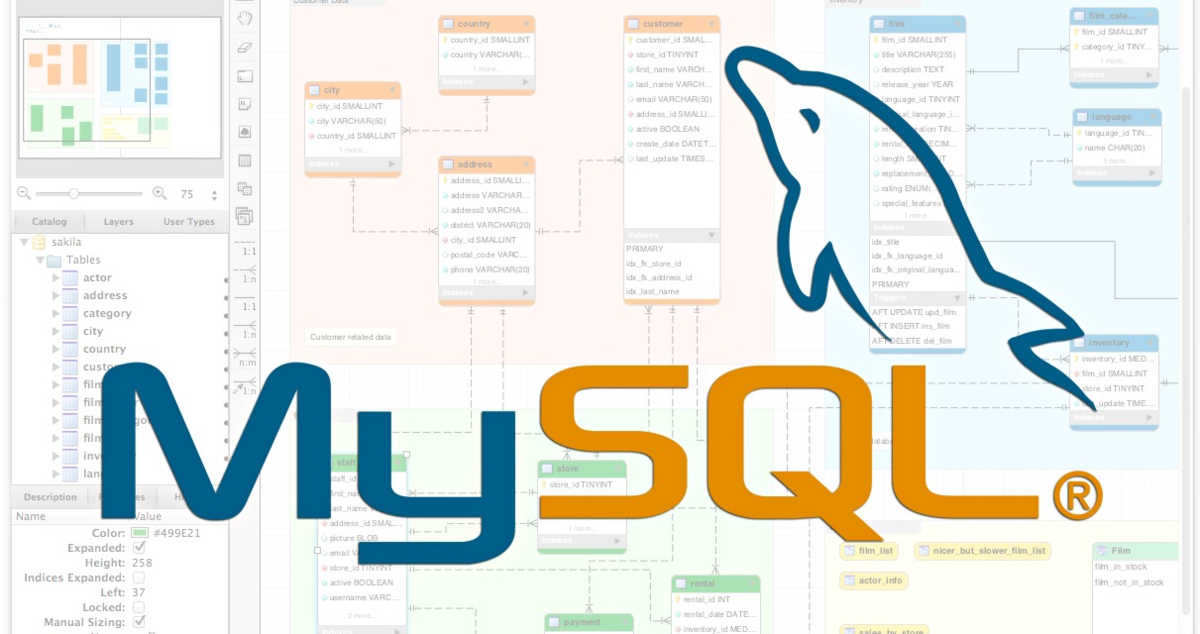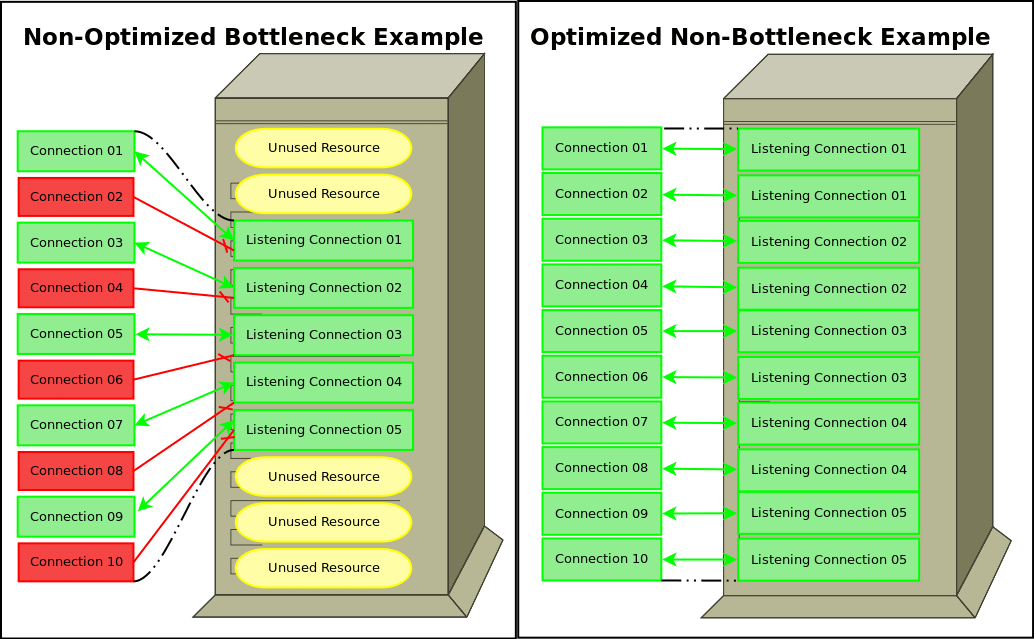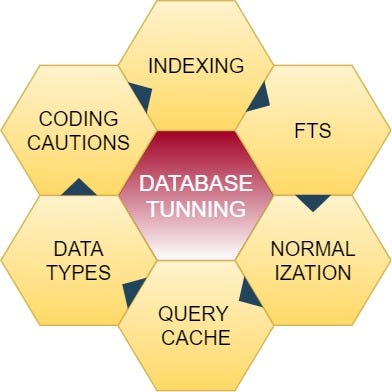An Intrinsic Ride into Oracle Database and SQL

Both Oracle and SQL are of great help when you want to manage data effectively. They improve the workflow in your company. Most companies hire data analysts to record, analyze and distribute data. These data analysts need to have a complete understanding of the goals of the company to use the data. Through this blog, we will learn about the benefits of Oracle Database and SQL and why you should use them.
Oracle database is an RDBMS that is used to access and manage data in a multi-user environment. Its security infrastructure can prevent unauthorized access and also offer efficient data recovery solutions. It comes in handy when you want to solve the problems that are related to information management. It is the first approach to implementing enterprise grid computing and a cost-effective way to manage information applications.
When you have a robust architecture, the system can handle peak workloads easily. You can allocate the capacity from the resource. These databases have logical structures and physical structures that won’t affect access to storage structures.
Benefits of My SQL Database and SQL
Oracle Database and SQL have different approaches to improving the company’s database. But you can also use other servers on the same database along with the cluster feature and increase processing power without any additional investment.
Along with that, MySQL Database and SQL are versatile and support a lot of operating systems. For example, when you use SQL Server on a window machine, it can improve the way Unix works and keep the standardization intact. Unix is less prone to viruses and your data is always secure. You can upgrade the system without losing data.
Oracle lets you restore database files during downtimes and outages. It supports user-managed recovery that lets you archive and recovers your data when online. It also prefers the use of real application clusters over traditional database servers. When needed it can also scale the database and also minimize data redundancy and availability.

SQL permits you to get rid of needless spending and be specific when it comes to storing databases. It is easy to say that it is an efficient solution. If you are comfortable working with it, you can store-track all the essential data and use it effectively.
Most of the already used database solutions track one thing at a time. But it also brings you all the data in one place. Along with that, it permits the execution of programming commands and does data analysis to update information whenever required. In short, it enables previously impossible data analysis.
Going for it brings in many benefits, as it keeps you updated. This language can help you stay relevant in changing times and become successful. You can learn it anytime.
To conclude
Both of these have their own advantages. They are data management systems that help you manage your data in an impressive and effective way. You can learn to work on them anytime and implement them in your organization. They are future-proof technologies that deliver even in changing times.

Establishing a Remote Connection for Secure SQL Server Performance

Security is a crucial factor when it comes to databases. Improving it involves access control and in that regard, the database engines of each SQL Server performance edition only allow it from the main computer. This remains true at least until the initial installation but what if you have to access your database from another system?
Fortunately, you can do so with the help of some simple steps which we have explained here. There are 4 major steps in total:
- Enable Protocol
- Configure Port
- Open Firewall Ports
- Make the connection from a different computer
This post is divided into four sections to explain the process involved in each step, so read carefully. You will require the SQL optimizer for SQL Server once the connection is complete.
Enabling Protocols for Proper SQL Server Performance
This is necessary if you want to establish a link from another device to the Database Engine. Start with the following:
- Go to the All-Programs section in the Start menu followed by Microsoft SQL Server > Configuration Tools > SQL Server Configuration Manager.
- Click on the SQL Server Configuration Manager and select the Protocols option. In it, make your selections for the protocols you require.
- Right-click on the chosen protocol and select the Enable option in MySQL database and SQL.

Adjusting Settings for Fixed Ports
The next step to initiate a remote connection to the Database Engine is to open a firewall communication port. This requires the user to first make adjustments in the settings to make the engine respond to a static or fixed port. Otherwise, it may focus on a different port at every instance.
Making a Firewall Port Available for Use
The firewall is likely to be turned on during remote use but it may affect SQL Server performance, so the user has to open a port in it as well for TCP access.
- Open Run, type WF.msc, and press Enter or click OK.
- Go to the Advanced Security section (located in the left pane) and select New Rule in the Inbound Rules option (after right-clicking).
- The Rule Type dialog box will open after this; click on Port, and then Next.
- Pick TCP or the protocol you want in the Protocol and Ports dialog box. Click Next.
- Select the Allow the connection option and choose Next.
- Pick out all the profiles you require in the computer connection surroundings when you initiate the remote connection and then click Next.
- Add a name and details to the rule and select Finish.
Final Step
Now, it is time to connect to the server. Click on the Connect to Server option and go to the SQL Server client tools. Go to the Database Engine option that is situated in the Server section.
Once it opens, type TCP to mention the name of the protocol. After that, type in the computer name, comma, and port digits as the prompts ask. You can then proceed to form a connection to the default instance, the system will assume port 1433 but you can replace it with the digits of your preference.
With this, you can establish a remote connection to the SQL Server Database Engine from your computer.

Update Methods that Improve MySQL SQL Performance Tuning

Sometimes, database users have to add data to a table from other tables. There is more than one way to do this - and we will explore all of them in this blog. We will also look at how these affect performance during MySQL SQL performance tuning.
These methods are all carried out with the help of the ‘UPDATE from SELECT’ query structure. That’s because the purpose of an UPDATE statement is to make the specified changes to the data in one or more rows in a table.
This query is designed to modify all the rows but the user can place restrictions on an UPDATE query to control the number and type of rows it can affect. This is usually done with the help of the WHERE clause.
Oracle SQL Performance Tuning: Various Selective Update Methods
The complete query helps in affecting the entire table information with a single value mentioned in the query. Placing a condition in the update query results in data changes where the condition is met. This helps with Oracle SQL performance tuning as it reduces redundancy, preventing a dip in performance.
However, due to a vast range of scenarios, this type of use alone is insufficient. Oftentimes, the users require data from various tables to update the table in question. Such update queries can get complicated in comparison with the typical update queries but there are simpler methods which we will discuss below:

Using the Subquery Technique
A subquery refers to an inner statement with utility within the Data Manipulation Language commands i.e., select, insert, update, and delete queries. An important distinctive feature of subqueries is their limitation to only process with the external statement.
This method is one of the simplest ways to update information from that of another table. However, there’s one evident difference between this and the other techniques we will mention - the subquery method is an easy method to perform updates for smaller tables with fewer rows.
Updating Using Join Technique
This strategy involves the updating and joining of the table with the table whose data needs to be replicated in the target table. This way, the user will be able to reach the matched information of the table it is referenced from on the basis of the particular join kind. If used incorrectly, you may need MySQL SQL performance tuning to maintain normal database function.
The user can also easily match the columns that require data changing by referencing the corresponding columns and applying the update process through this method.
Using the MERGE query
This query finds its use in the manipulation of tables through source table referencing that indicates the matched and unmatched rows. It helps with the insert, update, and delete functions, and is quite handy when a user has to synchronize the table from the source table of their choice.

In Summary
This blog has briefly covered all the techniques in the UPDATE from SELECT query structure to updating the information in a table with data from another table. Without these methods, users may require Oracle SQL performance tuning for acceptable results.
We can not only use subqueries but also take advantage of alternative methods such as MERGE and JOIN. The use of these techniques depends on the type of data update scenario.
5 Reasons You Can’t Improve MySQL Database Performance

One of the best things to do every time you encounter a performance issue is to check your wait stats. These provide reliable information as they continuously track execution threads, and this information will help you locate the exact cause behind the problem.
Although it is easy to find what’s causing the problem, interpreting the data and resolving the issue is rather difficult and time-consuming. In this blog, we’ll look at five possible reasons behind the performance issue you’re facing. Understanding these will help you take the right steps to improve MySQL database performance.
Improve MySQL Database Performance with Knowledge of these 5 Errors
Given below are five root causes of lagging execution threads that are affecting database performance:
- Expensive queries and saved procedures: Keep an eye on the stored processes and queries that are showing the maximum IO, CPU usage and are the most time-consuming. You’ll find you can often times enhance such queries to gain better performance while expending the least amount of resources. It’s worth a check, even if it isn’t the most interesting work for the majority of us.
- Abandoned performance counters: Performance counters prove useful in all cases regardless of whether the DBA resolves the immediate problem. That’s because performance counters help pinpoint the deeper problems.

Making a habit of monitoring performance counters will pay off in the long run by enabling the user to spot problems before they get bigger. It helps users improve oracle database performance as well. In other words, you’ll be able to conduct performance tuning on a targeted basis and gain a good baseline.
- Unoptimised TempDB database: If this database isn’t properly configured, it can lead to performance bottlenecks. In fact, this is often the case, so make sure to keep an eye out for several data files to see whether trace flags 1117 and 1118 are enabled; this setting is standard in newer versions of SQL Server.
Given below are certain tips to help you ensure an optimal temp DB:
- Consider PAGELATCH_XX wait-types as indicators of tempdb contention for further troubleshooting.
- As a general rule, there should be as many tempdb data files as there are logical processors if the number of CPUs is greater than eight.
- Reserve dedicated high-speed disks for your tempdb files.
- Maintain the size required for tempdb files.
- Leave IFI enables and select the option to have your files grow equally

- Too few index maintenance runs: The number of times you should run index maintenance depends on the amount of work you have and the rate at which the information changes. Knowing this is necessary if you want to improve MySQL database performance or SQL tuning for MySQL. In case you aren’t sure about the frequency of maintenance checks you should maintain; you can begin with daily index fragmentation checks.
For instance, if fragmentation reaches around thirty per cent in seven days, running a weekly index maintenance check is the right call. If fragmentation takes place sooner, make the runs slightly more frequent, such as twice a week with necessary statistic updates.
An important thing to remember in case you lack an index maintenance plan is that you can rely on SQL performance tuning tools with free scripts. Such scripts dynamically find out indexes in need of maintenance. Many database professionals use these tools for this purpose as it’s an excellent place to begin.
5. Keeping unused or underperforming indexes: Too many indexes can adversely affect performance, especially that of DML transactions. The goal here is to create appropriate indexes that have a favourable effect on the read performance that outpaces the negative effects on write performance. However, this needs a decent understanding of your workflow.

Download Free SQL Server with These Incredibly Simple Steps
SQL Server is an RDBMS (Relational database management system that was built by Microsoft to use with ANSI SQL. This is the standard SQL that SQL Server supports, although it uses its own version of the Structured Query Language known as Transact-SQL or simply T-SQL.

T-SQL and Microsoft SQL Server have been created in competition with Oracle and MySQL DBMSs. If you wish to download free SQL Server of the latest version, please go through this blog as we have explained the steps to do so.
Know the Prerequisites before You Download Free SQL Server
If you wish to download MS SQL Server for Windows 10, take a look at the minimum requirements:
- System Requirements: NTFS
- Memory Needed: 1 GB
- Other Requirements: .NET framework
Free SQL Tools for Windows: Steps to Download Free SQL Server Setup
Follow the steps given below to successfully download the setup for SQL Server:
Step. 1: Visit the official website of Microsoft SQL Server and navigate to the downloads page. There are two major editions that specialize in different aspects of its use. These are:

- Developer Edition - An edition that helps learners begin their use of MS SQL.
- Express Edition - Also a free version except that it comes with a comparatively limited set of functions and features, including a lack of business intelligence apps.
Step. 2: Select the "Download now" option by clicking on it. A file with the SQL Server and its version name will get downloaded in the folder you select.
Step. 3: Installing after you download MS SQL and free SQL tools for Windows
Complete the following steps to finish the download and installation process -
Step. 3 a. Click on the downloaded exe file to open it. The resulting window will offer three options: Basic, Custom, and Download.
Step. 3 b. Select your choice to proceed - Basic is recommended as it contains the default settings that help beginners pick it up.
Step. 3 c. Click on the “Accept” option to confirm your acceptance to the license terms - don’t forget to read them first!

Step. 3 d. Browse the available folders to pick the ideal location to install the application after you download free SQL Server. After that, choose “Install”.
Step. 3 e. When the installation process ends, a post-setup screen will appear to help you select additional configurations before you begin using SQL Server. Make your choices in the following fields and close the window:
- Instance name: You may go with the default name “MSSQLSERVER”.
- Connect now: To ensure a stable connection, this option will open a cmd window to test the connection of the installed software.
- Customize: Include additional features aside from those included in the Basic installation.
- Install SSMS: An Integrated Development Environment that enables users to gain access to the Microsoft SSMS download link. You may choose this option according to your requirement in terms of free SQL tools for Windows.
Once you have made your selections as per your specific needs, you can proceed to click on the Close button. All the changes and additional installations take place once you close this window.
Underrated Ways to Improve Oracle Database Performance

No database admin wants to answer phone calls from customers complaining about slow database performance. To improve Oracle database performance, take some time out for performance tuning. It helps you recognize the shortcomings and make sure the infrastructure is capable of handling increased loads.
If you are not sure how to begin improving database performance, follow the below-mentioned steps:
1: Focus on Baselines
Making a performance baseline helps you identify a problem. It is a practical performance tuning method that allows you to compare your present database performance to a baseline and determine whether there is a problem or not. For that, you need to establish performance targets and have a clear understanding of your system’s efficiencies. Additionally, you should constantly measure your database performance so you can easily identify bottlenecks when they occur.
2: Identify SQLs that are Ineffective
Resolving issues in an Oracle database isn’t as difficult as it sounds. One of the most effective ways is by tuning the SQL application and using a proper query plan. You can improve Oracle database performance by:
- Identifying and targeting the SQL that is causing a problem to the user. For example, when a user complains that a certain inquiry form opens in 40 seconds, you should define the problem and make sure it open within 5 seconds.
- You also need to keep tracing and measuring the database sessions. There are plenty of tracing tools that you can use for that. These tools help you determine statics, SQL performance, execution plan as well as the wait time cost.
Defining the problems beforehand helps you tackle them when they come up again in the future.

3: Boost Storage Performance
Do you take note of the storage platform your database runs on? If not, pay close attention to it. Reviewing your storage options from time to time helps you identify and remove errors in the database server.
4: Offer a Dedicated Infrastructure for the Database
Sometimes even after using the best possible DBA tuning techniques, the database runs slowly. This is due to the use of a common infrastructure platform. For organizations that deal with massive data, a dedicated database infrastructure can help. Segregating the infrastructure allows you to ensure consistently high performance, easy monitoring, and security.
5: Appropriate CPU Utilization
While there are various diagnostic tools to handle a problem, you can always rely on manual processes for better results. Keep an eye on your CPU utilization when examining any performance issues. It helps you notice any non-database-related tasks consuming the CPU and limiting its performance.
IN CONCLUSION
We hope the above-mentioned tips help you improve Oracle database performance. We have curated this list from questions that we encounter on a regular basis. So, if you have any questions regarding any of the points, please leave a comment below. Our experts would love to address your concerns so you can ensure an error-free database.
If you think we should cover more such topics on database performance and DBA tuning, feel free to share those ideas with us. Our writers would appreciate your feedback and suggestions.

Optimization in SQL to Improve MySQL Database Performance

Preserving the performance of your database needs to be done properly. Otherwise, the entire organization suffers because of a slow database.
Sometimes, all it takes is one poorly written statement to make database execution utilize an excessive amount of resources and make the administrator realise the importance of optimization in SQL. Therefore, they also have the responsibility of locating such sluggish queries, that are the root cause behind slow performance, and rewriting them - a process known as SQL query tuning or query optimization in SQL.
DBAs and other database professionals need to approach performance issues by reconsidering their current strategies and selecting the ones that take the least time and computational resources to carry out a SQL statement. This includes the use of an optimization tool - software that is designed to provide optimal versions of queries. While this might be the primary goal of most such tools, they are often given other useful features for even more benefits. These include providing insights with the help of data statistics based on accessed information.
Such tools are often indispensable to an organizational database administrator due to many reasons. Some such advantages are mentioned below:
They save them the effort and time of locating and resolving the issues manually.
These tools enhance the rate of query execution and other database operations.
Not only do such tools improve MySQL database performance, but they also prove effective while monitoring and boosting the efficiency of SQL servers for quicker, more reliable outcomes.
One of the major tasks of a SQL optimization tool is to provide the best alternatives to the target query. It does so by examining several query plans.
Top Features of Tools for Optimization in SQL
Given below are the major functions of popular SQL optimization tools:
SQL Query Tuning - Needless to say, this is the most important task carried out by a database query optimizer. This is done by analyzing the query that has to be modified and then providing the better version of it. Both provide the same results but one of them can do it faster while taking up fewer resources.
Compatibility with multiple devices - Since most such tools work online and can be run using virtually any device with an internet connection, they prove quite handy in many situations.
Supports several database environments - DBAs prefer tools that keep up with the technological advances, which is why the creators of tools for optimization in SQL ensure compatibility with as many of the current database environments as possible. These include Oracle, MySQL, PostgreSQL, Maria, and Microsoft SQL.
Works with cloud technologies - Many of these tools have been designed to monitor, evaluate, and improve MySQL database performance stored in the cloud, including Microsoft SQL Azure and Amazon's AWS RDS.

